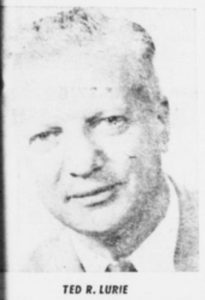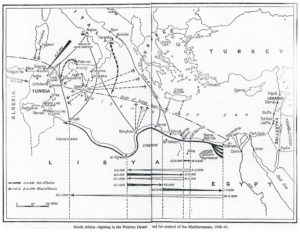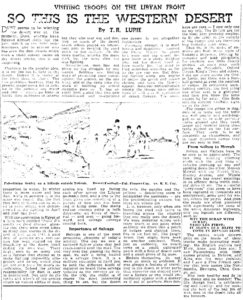On Friday, May 8, 1942, The Palestine Post published the second of Ted Lurie’s reports about the military service of troops from the Yishuv in the British Eighth Army. This news item focused on the three Pioneer Companies of the Royal Army Service Corps (two Jewish and one Arab) serving in Libya and Egypt, respectively. Immediately apparent is that Lurie’s reporting is based on encounters and interviews with the soldiers serving in these units, this involving travel of approximately 1,000 miles west from the Yishuv, along the Mediterranean coast of Africa. As you can see in the image below, Lurie’s article was accompanied by two photos, but these are barely visible in the digital version of the article.
________________________________________
PIONEERS IN THE DESERT
By T.R. LURIE
The Palestine Post
May 8, 1942
This is the second of a series of articles by The Palestine Post News Editor who has just returned from a tour of camps of Palestinian Soldiers in Egypt and Libya.
PALESTINIANS are Pioneers with Gen. Ritchie’s Eighth Army in the Western Desert. Three Companies of the Auxiliary Military Pioneer Corps, two Jewish Companies and one Arab, are encamped and doing important jobs – the first two in Libya and the third in Egypt.
Two of them are working at different point along the Eighth Army’s vital supply lines, while one, number 601, is in the Tobruk area. In the record-breaking construction of the new desert railway by New Zealand engineers these Palestinian Pioneers played an important part.
The Tobruk Company is now a Jewish unit but when originally formed as the first Palestinian Company to be enlisted it was a mixed Company. They are the men who served in France and later were in the Battle of Britain, after having been armed during their last days in France. Their overseas service won them high praise, as has already been noted in these columns, and now they are carrying on the reputation earned for Palestinians in Tobruk by the Jewish transport companies of the R.A.S.C. who served with the Australians during the 1941 siege.
A Year in the Desert
I did not visit 601 at Tobruk, but I travelled almost 1,000 miles to see the other two: 600 (Jewish) and 610 (Arab). The first has been in the desert almost a year, starting in Egypt and by stages moving up to more forward positions until now they are on the other side of the wire. Their exact location in Cyrenaica [eastern coastal region of Libya] can, of course, not be disclosed, but I found them – a pin point on the map already diligently working at a dozen different tasks although they were still in the process of digging in.
They had a few days before broken camp near an old railhead site in Western Egypt and had moved forward to this point somewhere between Capuzzo [Fort Capuzzo] and Bardia. A detachment of Greek troops has been attached to the company here. The pioneers’ jobs range from sorting mail at the Field Post Office, digging pits for telegraph poles to working on munitions dumps, and many other jobs which an army has do along its lines of communications.
I saw the men – those who were not out in detachments at work some distance from the camp – at lunch-time messing in the open near the cook-house. They had just received the Passover gift parcels sent by the Jewish Soldiers Welfare Committee and were of course delighted to have them at their new camp, which more than made up for their late arrival. Some of the men had been home on leave for Passover and were still talking about it at mess that day while others described the thrill they had experienced by the surprise visit of Mr. M. Shertok [Moshe Chertok] who had come to their camp at their old site to spend the Passover Feast (Seder) with them.
Men from the Patria
I spoke in English to a husky Sergeant who was only a beginner at Hebrew because he had come to Palestine in the Patria from Austria only a short time before enlisting. There are several men from Patria and Tiger Hill and other refugee ships in this company together with boys born in Jerusalem and other towns, and farmers from Herzlia and other villages. Many of them are skilled artisans and craftsmen, and their only ambition is to do work for which they are well qualified as an Artisan Works Company in the Res. or a Works Services Company of the R.A.S.C.
The food is good and plentiful, and even Tubby, the fat boy, (20 stone if he’s a pound) cannot complain on that score. The men all live under canvas, some in small “bivys,” others in large dug-in sand-bagged tents, as they have not yet had time to build proper dug-outs.
IT was not easy to find 610 Company. We started at Mersa Matruh, travelled a couple of hours west on the coastal road and then turned off south on a desert track. Tracks soon disappeared in the brush and we made the rest of the journey guided only by maps and compass bearings. We bounced over thick desert shrubs for another couple of hours until we found our pin-point: 610 A.M.P.C.
An Arab Unit
This Company includes some of the Arab soldiers who had joined 601 on its formation as a mixed company and had been transferred to 610 when the former was reconstituted as a Jewish unit. The two had been in France and some had later been in a Commando at Abyssinia. Theirs is the only Arab Company serving outside Palestine, and they have been in Egypt about six months.
Most of the men are from Jaffa, but nevertheless they take to the desert “not too badly,” in the words of one of their officers. The boys from the towns are even better, this officer said, then the native desert dwellers themselves. They are in good spirits and on the least occasion – such as an ordinary pay day – they will hold a celebration and dance the debka, using bivy tent-poles for swords. They too receive comforts from Palestine: sports gear, indoor games, newspapers, etc.
Although the men speak only a little English, their officers manage to make themselves understood. One of the officers – then with the Buffs Regiment – was in Palestine in 1936 and later, in 1940, was a training officer for Palestinian recruits at Sarafand.
The men themselves are keen on firearms, I was told, especially Lewis and Breda guns. Nothing gives them more of a kick than a chance to fire their machine-guns at enemy planes. A couple of hits scored on one raider were identified as coming from their gun when the machine crash-landed later. These men were hard to find in the Egyptian desert – being so well dug in – but they were, tawny and grinning, doing their bit.




